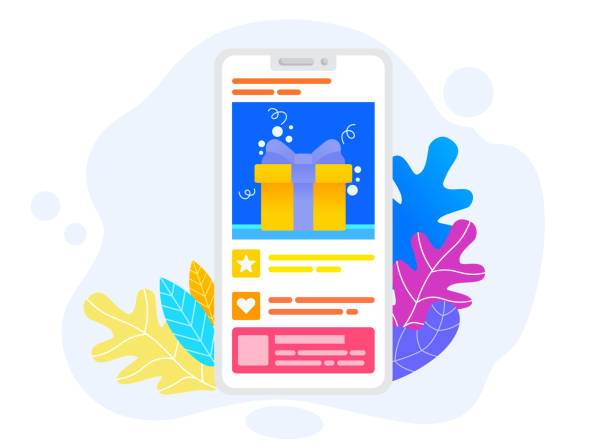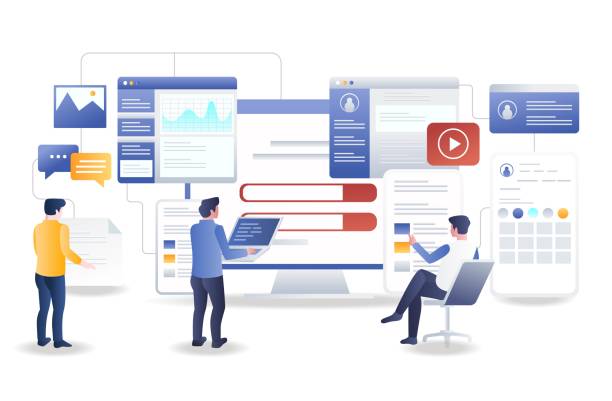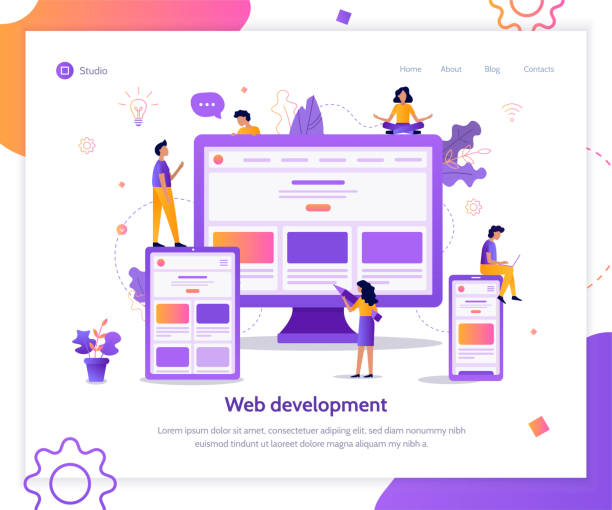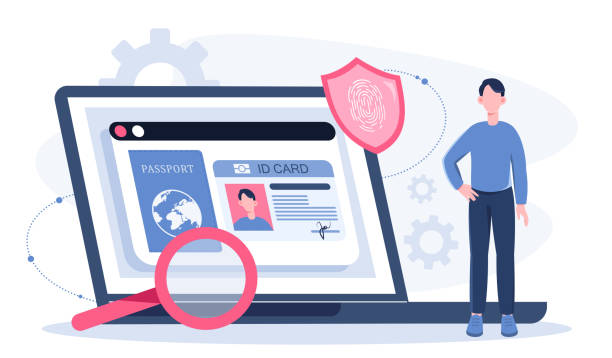Introduction to User-Friendly Website Design and Its Importance

In today’s digital world, having a website is not just about having an online presence; the quality of this presence is vitally important.
User-friendly website design means creating an environment where users can easily interact with it, find the information they need, and achieve their goals.
This approach not only creates a positive experience for visitors but also directly impacts the success of your business.
A poorly designed website can quickly drive visitors away, while a smart design can turn them into loyal customers.
The importance of #UserFriendlyWebsiteDesign stems from the fact that today’s users have high expectations of websites; they want speed, ease of access, visual appeal, and clear guidance.
If your website cannot meet these needs, they will simply turn to your competitors.
Therefore, investing in #UserExperience and #EffectiveUserInterface is no longer an option, but a necessity.
This not only increases website traffic but also improves conversion rates and enhances your brand’s credibility.
In fact, a web design focused on user needs is the foundation of any successful digital marketing strategy.
This educational and explanatory article will help you understand the fundamental principles of this field and build a website that is not only beautiful but also effectively serves your users and helps them achieve their goals.
Does your current website convert visitors into customers or drive them away? Solve this problem forever with professional corporate website design by Rasawab!
✅ Create strong credibility and branding
✅ Attract target customers and increase sales
⚡ Get a free consultation now!
Basic Principles of User Experience (UX) in Website Design

User Experience, or UX, goes beyond the visual aesthetics of a website; this concept refers to the user’s overall feeling when interacting with your website.
In fact, user-friendly website design is deeply rooted in UX principles.
One of the most important principles is “Usability”; users should be able to perform their tasks quickly and without confusion.
This includes easy navigation, clear buttons, and specific calls to action (CTA).
The next principle is “Efficiency”; users should not spend a lot of time performing a simple task.
Optimizing processes, such as short forms and fewer checkout steps, is of high importance.
“Satisfaction” is also a key element; does your website give the user a good feeling? Does it meet their needs? Relevant and responsive content, attractive design, and smooth interactions contribute to this feeling.
“Accessibility” is another vital principle that ensures the website is usable by everyone, including people with disabilities.
This is a specialized and guidance principle that should be considered from the outset.
For example, using alt text for images or keyboard navigation capabilities are examples of adhering to accessibility.
These principles not only help improve SEO rankings but also lead to branding and customer loyalty.
Ultimately, user-friendly website design means ensuring that every interaction with your website is positive and fruitful.
The Importance of User Interface (UI) Design and Aesthetics on a Website

While UX addresses the overall user experience, UI (User Interface) refers to the visual and interactive aspects of a website.
A beautiful and intuitive UI is an inseparable part of user-friendly website design.
Aesthetics are the first thing that captures a user’s attention and makes a strong initial impression.
Colors, fonts, images, and the overall layout must all be harmonious and convey a clear message to the user.
Using an appropriate color palette can evoke specific emotions in the user and encourage more interaction.
Proper typography also increases text readability and makes the website appear more professional.
The layout should be logical and predictable, so that the user can easily find important elements.
A good UI is not only beautiful but also functional and provides clear visual guidance.
For example, call-to-action (CTA) buttons should be prominent and easily recognizable.
This part of website design is specialized and educational and requires a deep understanding of graphic design principles and user psychology.
The ultimate goal is to create a website with easy usability that is both visually appealing and efficient.
The table below compares some aspects of good and bad UI:
| Feature | User-Friendly Interface | Poor Interface |
|---|---|---|
| Fonts and Readability | Appropriate size and color, high contrast | Small or unreadable fonts, low contrast |
| Visual Consistency | Consistent visual elements throughout the site | Sudden changes in style, color, and form across different pages |
| Interactive Feedback | Button color change on click, success/error messages | Lack of element response to clicks or user input |
| Layout and White Space | Sufficient white space for element breathing room, organized layout | Cluttered elements, busy and disorganized page |
Responsive Design and Mobile-First Approach

In this era, where smartphones and tablets have become the primary tools for internet access, the importance of responsive design for user-friendly website design becomes more apparent than ever.
Responsive design means that your website should adjust its appearance and functionality to the screen size of the user’s device.
This ensures that the user experience, whether on a large desktop screen or a small smartphone, is consistent and optimized.
The “Mobile-First” approach is also a design philosophy that designs for mobile devices first, and then scales it up for larger screens.
This approach is very important because search engines like Google prioritize mobile-first websites in their rankings.
Ignoring responsive design can lead to losing a large portion of your audience, as users quickly abandon websites that do not offer a good mobile experience.
This part of the design is explanatory and educational and includes the use of CSS Media Queries and flexible grid systems.
A user-friendly website must ensure that images, texts, and layouts are displayed correctly at any size, without the need for zooming or horizontal scrolling.
This not only increases user comfort but also adds to the credibility and professionalism of your website and ultimately greatly contributes to ease of website use.
Does your current corporate website present a worthy image of your brand and attract new customers?
If not, turn this challenge into an opportunity with Rasawab’s professional corporate website design services.
✅ Significantly improves your brand’s credibility and image.
✅ Paves the way for attracting new leads and customers for you.
⚡ Contact Rasawab now for a free and specialized consultation!
Information Architecture and Intuitive Navigation

Information Architecture (IA) refers to organizing and structuring website content in a way that users can easily find the information they need.
This is the foundation of a user-friendly website design.
Poor information architecture, even with the most beautiful user interface, can lead to user confusion and frustration.
IA involves categorizing content, creating a logical hierarchy, and designing intuitive navigation systems.
Navigation menus should be clear, concise, and predictable; users should always know where they are on the website and how to get to other sections.
Using “Breadcrumbs” and appropriate internal links helps users move through the website structure.
Intuitive navigation means that the user knows how to go from one page to another without needing to think too much.
This part of the design is specialized and guidance-oriented and is vital for website success.
This requires a deep understanding of users’ mental models and how they search for information.
A user-friendly website should have a logical sitemap and powerful search systems to help users quickly find their desired content.
Ultimately, strong information architecture and smooth navigation lead to a reduction in bounce rate and an increase in user time spent on the site, both of which are important factors in Search Engine Optimization (SEO) and ensure an easy-to-use website experience.
Loading Speed and Website Performance Optimization

Website loading speed is one of the most important factors in user-friendly website design and directly affects user experience and SEO ranking.
Studies have shown that even a one-second delay in page loading can drastically reduce conversion rates and lead to user dissatisfaction.
Today’s users, especially on mobile, have high expectations for speed and quickly abandon slow-performing websites.
Website performance optimization includes actions such as image compression, caching, minimizing CSS and JavaScript codes, and using Content Delivery Networks (CDNs).
These aspects of website design are analytical and explanatory and require technical knowledge.
A user-friendly website design should be carried out from the very beginning with loading speed in mind.
This means that images should be of appropriate size and in optimized formats (like WebP), videos should not autoplay unless the user wishes, and codes should be clean and tidy.
Tools like Google PageSpeed Insights can help identify weaknesses in loading speed.
Increasing speed not only ensures a good user experience but also helps improve the website’s ranking in search engines, as page speed is a key ranking factor.
Therefore, performance optimization is essential not only for users but also for the overall success of your website and leads to a user-friendly website.
Accessibility for All Users

Web accessibility means designing and developing websites in a way that people with disabilities can also effectively use them.
This is a critical element in user-friendly website design and a social responsibility.
The goal is to remove barriers that might prevent individuals with visual, auditory, motor, or cognitive impairments from accessing information or interacting with the website.
This issue is not only important from an ethical standpoint but is also legally mandated in many countries and can lead to an increase in your audience and customers.
Adhering to WCAG (Web Content Accessibility Guidelines), provided by the World Wide Web Consortium (W3C), helps create a user-friendly website for everyone.
These guidelines include using alt text for images, providing captions for videos, ensuring appropriate color contrast for readability, keyboard navigation capability, and designing accessible forms.
This section is educational and specialized and shows how comprehensive and inclusive user-centric website design is.
Failure to pay attention to accessibility can lead to the loss of a significant portion of users and even legal issues.
Additionally, many accessibility features indirectly help improve SEO, such as using semantic HTML structure and logical content organization.
Ultimately, a truly user-friendly website design is one that excludes no one from accessing its information or services.
The table below shows some common accessibility problems and their solutions:
| Common Problem | Impact on User | Accessibility Solution |
|---|---|---|
| Lack of alt text for images | Blind users cannot understand image content. | Use `alt` tag with appropriate description for all images. |
| Low color contrast of text and background | Difficulty reading text for people with visual impairments. | Ensure sufficient contrast ratio (at least 4.5:1) according to WCAG. |
| Inability to navigate with keyboard | Users with motor limitations cannot use a mouse. | Ensure all interactive elements are focusable and have a logical Tab order. |
| Lack of captions or transcripts for audio/video content | Ineffective for deaf or hard-of-hearing users. | Provide accurate captions and full transcripts for all multimedia content. |
User Testing and Continuous Feedback

After design and implementation, the work of user-friendly website design does not end.
User Testing and gathering feedback are critical processes to ensure that your website is truly user-friendly.
These processes allow you to discover hidden problems, confirm or refute your assumptions, and improve the website based on actual user needs.
There are various methods for user testing, including Usability Testing where real users perform specific tasks on the site, and their behavior and reactions are observed.
A/B Testing is also a popular method where two different versions of a page or element are shown to different users to see which one performs better.
Surveys, interviews, and heatmaps are also valuable tools for collecting feedback.
This stage of design is analytical and guidance-oriented.
The collected data must be carefully analyzed to identify patterns and weaknesses.
This information should then be used to make iterative improvements in website design.
A user-friendly website is the result of a continuous process of design, testing, analysis, and optimization.
The more you engage with your real users, the better you can understand their needs and build a website that not only meets their expectations but also delights them, leading to a good user experience.
Does your current site showcase your brand’s credibility as it should? Or does it scare away potential customers?
Rasawab, with years of experience in designing professional corporate websites, is your comprehensive solution.
✅ A modern, beautiful site tailored to your brand identity
✅ Significant increase in lead and new customer attraction
⚡ Contact Rasawab now for a free corporate website design consultation!
Common Mistakes in User-Friendly Website Design and How to Avoid Them

Even the most experienced designers can fall into traps that can harm the website’s user experience.
Awareness of these mistakes and how to avoid them is an important step towards user-friendly website design.
Is your website too cluttered? One of the most common mistakes is “cluttered and messy design” where too much information or visual elements are placed on one page, confusing the user.
“Complex and illogical navigation” is another error that prevents users from reaching their destination.
Are your call-to-action buttons clear? “Lack of clear call to action” makes the user unsure what to do next.
“Inconsistent Design” across different pages can also sidetrack the user.
These questions are examples of thought-provoking content that you should always ask yourself.
Another mistake is “lack of mobile optimization,” which leads to a poor user experience on mobile devices.
“Ignoring user feedback” and not conducting usability tests can also result in a website that is only good from the designer’s perspective.
This section is guidance-oriented and specialized.
To avoid these mistakes, always consider user-centric design principles, keep the design simple, use white space correctly, build intuitive navigation, and regularly test and evaluate your website from the user’s perspective.
By avoiding these common mistakes, you can ensure that your website is not only beautiful but truly user-friendly and effective.
Effects of User-Friendly Website Design on SEO and Website Ranking

The relationship between user-friendly website design and Search Engine Optimization (SEO) is very deep and reciprocal.
Search engines like Google are constantly striving to provide their users with the best and most relevant results, and this includes websites that offer excellent user experience.
Factors such as page loading speed, responsiveness, logical information architecture, easy navigation, and low bounce rate are all key elements of user-centric web design that directly affect SEO ranking.
Websites with high loading speeds and good mobile experience are rewarded by Google and ranked higher.
Correct information architecture and logical internal linking help search engine crawlers better understand and index site content.
A low bounce rate and long user time on site indicate user satisfaction with the content and design, which is also a positive signal for search engines.
This section of the article is analytical and informative, as Google’s algorithms are constantly being updated to identify and rank websites that provide a better user experience.
Therefore, investing in user-friendly website design not only means satisfying users but also significantly improving SEO and increasing your website’s visibility in search results.
An easy-to-use website naturally attracts more organic traffic and leads to long-term success.
Frequently Asked Questions
And other services of Rasa Web advertising agency in the field of advertising
Smart Brand Identity: A fast and efficient solution for customer acquisition with a focus on custom programming.
Smart Google Ads: Professional optimization for online growth using marketing automation.
Smart Custom Software: A creative platform for improving customer acquisition with Google advertising management.
Smart Advertorial: A dedicated service for digital branding growth based on Google advertising management.
Smart Sales Automation: An innovative service for increasing click-through rates through marketing automation.
And over hundreds of other services in the field of internet advertising, advertising consultation, and organizational solutions
Internet Advertising | Advertising Strategy | Advertorial
Resources
Complete Website Design Guide
Principles of User Experience in Website Design
How to Have an SEO-Friendly Website?
Tricks to Attract Website Visitors
? For your business to soar in the digital world, Rasawab Afarin, by providing innovative marketing solutions and fast and professional website design, is by your side to ensure a powerful and lasting presence.
📍 Tehran, Mirdamad Street, next to Bank Markazi, Southern Kazeroon Alley, Ramin Alley, No. 6



